Eye tracking techniques could help primary carers diagnose autism sooner

With the number of children needing autism spectrum evaluations completed far exceeding the available number of specialists to provide a diagnosis, researchers around the world are exploring alternative ways in which a diagnosis can be made earlier.
A collaborative team of researchers from Indiana University and Purdue University are adding their expertise to the mix, publishing a paper which describes the research team’s study of autism diagnosis using eye tracking biomarkers at primary care clinics across Indiana.
The team traveled to practices participating in the Indiana Early Autism Evaluation Hub system and conducted a blind research-grade evaluation of 146 children aged 14-48 months of age.
“Diagnostic biomarkers are characteristics that provide discrete and objective indication of diagnosis. Eye-tracking biomarkers that measure social and nonsocial attention and brain function have been shown to differentiate young children diagnosed with autism from those with other neurodevelopmental disabilities,” senior author Rebecca McNally Keehn said.
To do the eye tracking, children in the study sat in a highchair or caregiver’s lap and watched videos on a computer screen, while the researchers recorded their eye movements and pupil size. When primary care clinician diagnosis and diagnostic certainty was combined with eye-tracking biomarker metrics, the sensitivity of the model was 91 per cent and the specificity was 87 per cent, meaning that they made a more accurate autism diagnosis.
Assistant Professor McNally Keehn said studies like these can help address delays in access to autism evaluations by better equipping primary care clinicians with a multi-method, diagnostic approach.
“This is a public health issue, and our approach has the potential to substantially improve access to timely, accurate diagnosis in local communities,” she added.
The team’s next step is to conduct a large-scale replication and validation study of their diagnostic model using artificial intelligence. Then, they hope to conduct a clinical trial studying the effectiveness of the diagnostic model in real-time primary care evaluations.
Popular

Workforce
Quality
Practice
Provider
Research
How one teacher is using Little J & Big Cuz to build empathy, understanding and confidence in First Nations learning
2025-12-08 07:15:19
by Fiona Alston

Quality
Policy
Practice
Provider
Economics
Research
Workforce
NQF Annual Report 2025: Quality gains continue, but sector faces compliance pressures and persistent equity gaps
2025-12-10 07:21:19
by Fiona Alston

Research
Provider
Intentional science play: a three‑stage pathway to foster children’s scientific literacy in the early years
2025-12-10 07:45:26
by Fiona Alston
















